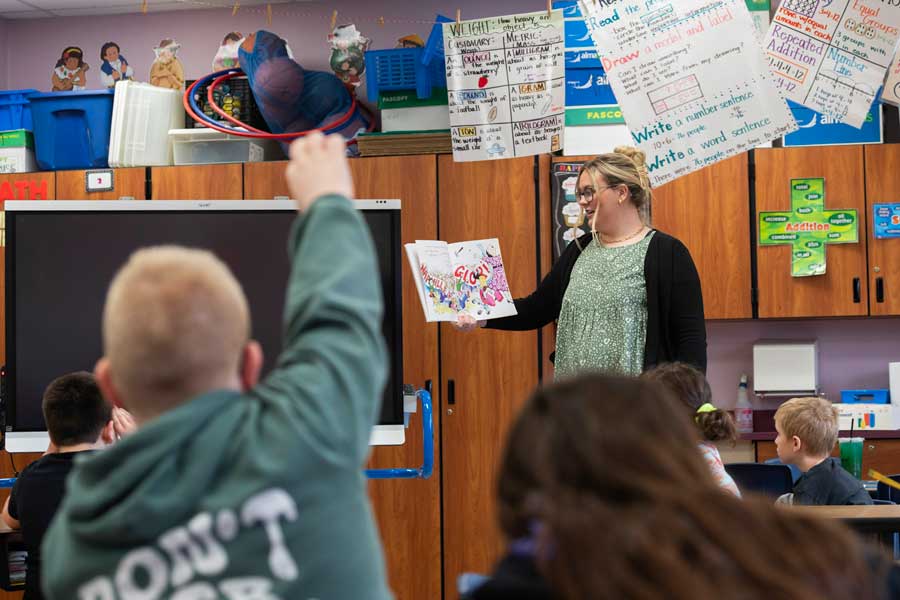Educators wanted
Pitt-Bradford's grads play important role in filling teaching positions in rural areas

Northwest Pennsylvania has some of the highest educator attrition rates in the state.
From 2022 to 2023, 8.3% of teachers in McKean County and 9.5% of teachers in Warren County left the profession, according to a research brief from the Center for Education Evaluation and Policy Analysis at Penn State.
In Elk, Potter and Cameron counties, rates were lower. Statewide, 7.7% of teachers left the classroom last year, totaling 9,587, the largest number of teachers leaving on record in Pennsylvania.
“There is absolutely a teacher shortage that we have been starting to see for about six years,” said Dr. Harley Ramsey, superintendent of schools for the Saint Marys Area School District.
That makes the newly minted educators graduating from the University of Pittsburgh at Bradford more important than ever to the regional economy.
One theory of increased teacher attrition in rural areas is that those teachers are recruited into larger suburban districts after a few years. That’s part of what makes Pitt-Bradford’s homegrown graduates attractive to area school districts. Those students have already gotten to know and like the area or perhaps even grown up or have close ties to the region: 22.6% of Pitt-Bradford students come to the university from its primary service area of McKean, Elk, Potter, Cameron, Warren, Forest and Elk counties.
Matt Splain, superintendent of Otto-Eldred Schools, knows he must sell his school district to teaching candidates. “You try to promote what we have to offer in our school climate and environment,” he said.
Dr. Jonathan Chitiyo, associate professor of education and director of the education program at Pitt-Bradford, said he and his education colleagues are actively involved in trying to address the teacher shortage by rigorously recruiting students into the program and retaining them.
They’re also helping to retain new teachers by making sure they’re adequately prepared when they graduate because new teachers are more likely to leave the profession if they are not ready for the classroom.
“When students come straight out of college, it can be overwhelming,” he said.
To help put students at ease and make sure they are a good fit for teaching, Pitt-Bradford faculty like to have their pre-service teachers in front of K-12 students early and often.
Even before pre-service teachers are admitted into the education program as juniors, they will have spent 70 hours in classrooms observing and tutoring children one-on-one.
With new regulations from the Pennsylvania Department of Education, some Pitt-Bradford students also will have spent time as a substitute teacher. Recently, the department began allowing education students who have taken at least two years’ worth of courses (60 credits) to substitute teach.
“During winter break, we’ll see students who will work substitute teaching,” said Jeannine Kloss, superintendent at Kane Area School District. Because Pitt-Bradford’s spring semester ends in the end of April, students can also substitute teach for a month before the end of most public-school districts’ academic years.
That’s another opportunity for pre-service teachers and school districts to get to know one another.
Superintendents aren’t just welcoming Pitt-Bradford students into their districts, they’re coming to campus to get to know students and put their name out there in front of them.
Splain speaks to the university’s Introduction to Education course to connect with pre-service teachers and talk with them about things happening in education.
He also takes part in mock interviews with students each year.
“We’ve always been fighting against other school districts for the good candidates out there, but we don’t have as many candidates in programs,” he said. “Now we joke about who is going to hand out their business card first.”
Ramsey, from St. Marys, said that’s because Pitt-Bradford teachers are well respected in the region.
“I think Pitt-Bradford does an exceptional job placing pre-service teachers with quality teachers in our districts where they leave with a solid understanding of the rural context,” he said, praising the university for its work to establish relationships with high-quality mentor teachers for its student teachers.
“School districts in the Northern Tier tend to really seek Pitt-Bradford teachers. They’ve been successful.”
Kloss agrees. “Pitt-Bradford is an important source of teachers for us. We really appreciate our partnership with Pitt-Bradford. They do turn out quality student teachers, and we appreciate that we have that option here with them.”
At the end of this academic year, Pitt-Bradford will have contributed 20 new teachers to the workforce – 14 in early-level education (preK-4th grade); two in English education for grades 7-12; three in health and physical education (K-12) and one in mathematics (grades 7-12). That’s the largest number in 10 years, although others have had nearly as many.
Taylor Sutryk ’23 is in her first full year as a health and physical education teacher at Floyd C. Fretz Middle School in Bradford after graduating last year. She came to Pitt-Bradford from the Corning, N.Y., area and elected to stay after doing her student teaching in the Bradford Area School District.
“I felt welcomed coming here,” she said of her experience in the district. “I had a lot of teachers by my side, walking me through.”